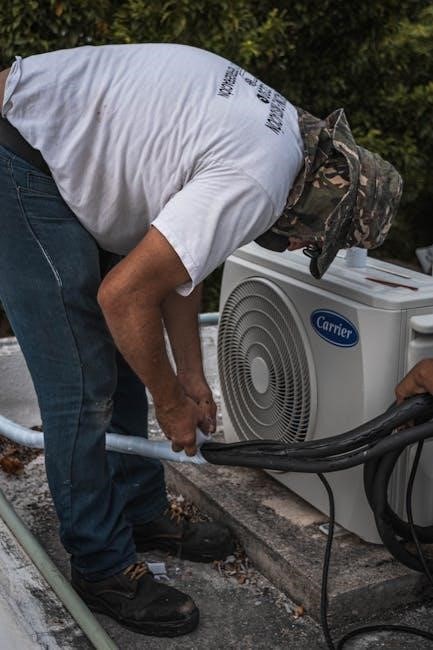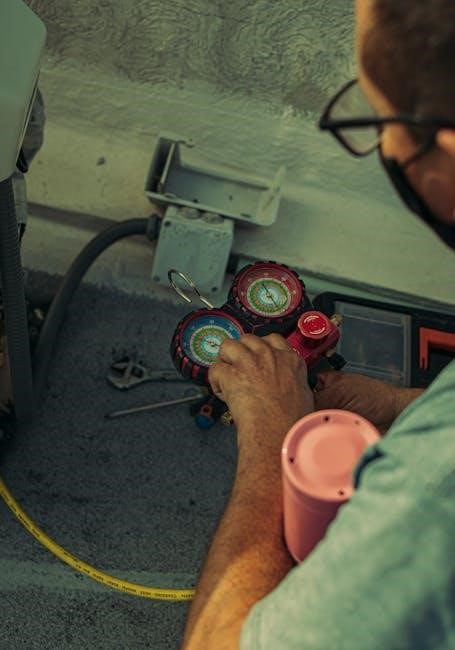Manual dampers are essential HVAC components, enabling precise airflow control and balance. They are cost-effective, manually adjusted, and crucial for efficient heating and cooling in various systems.
1.1 What is a Manual Damper?
A manual damper is a crucial component in HVAC systems, designed to control airflow within ducts. It operates via a handle or lever, allowing users to adjust airflow distribution manually. Unlike automatic dampers, manual dampers require physical adjustment and are commonly found in residential and commercial settings. They are typically round or rectangular and serve to balance airflow, reduce energy waste, and optimize system performance. Manual dampers are simple, cost-effective solutions for managing air distribution, ensuring efficient heating and cooling in various environments.

1.2 The Role of Manual Dampers in HVAC
Manual dampers play a vital role in HVAC systems by regulating airflow distribution. They enable precise control over air volume, ensuring optimal heating and cooling in specific zones. By adjusting airflow, manual dampers help balance system performance, reduce energy waste, and prevent overcooling or overheating. They are essential for maintaining consistent temperatures, improving comfort, and enhancing system efficiency; Additionally, manual dampers allow for cost-effective solutions in both residential and commercial settings, offering a straightforward method to manage airflow without the need for automated controls.

Types of Manual Dampers
Manual dampers come in various types, including round, rectangular, balancing, and zone control dampers, each designed for specific HVAC applications and airflow regulation needs.
2.1 Round Manual Dampers
Round manual dampers are widely used in HVAC systems for their simplicity and effectiveness. Designed with a single blade, they regulate airflow in ducts, ensuring even distribution. Constructed from durable materials like galvanized steel, these dampers are ideal for residential and light commercial settings. They feature a hand-adjustable quadrant mechanism, allowing precise control over airflow. Round dampers are often installed in branch ducts to balance air flow, making them essential for maintaining system efficiency and comfort. Their compact design and ease of installation make them a popular choice for HVAC applications requiring manual airflow adjustment.
2.2 Rectangular Manual Dampers
Rectangular manual dampers are versatile components in HVAC systems, designed for precise airflow control. Constructed from durable materials like galvanized steel, they are ideal for larger duct systems. These dampers feature a manually adjustable blade, operated by a lever or handle, allowing for airflow regulation. Commonly used in commercial and industrial settings, rectangular dampers are effective for balancing airflow in main ducts or branch lines. Their robust design ensures long-lasting performance, making them a reliable choice for maintaining system efficiency and directing airflow to specific zones as needed.
2.3 Balancing Dampers
Balancing dampers are specialized manual dampers used to regulate and equalize airflow within HVAC systems. Designed for precision, they are typically installed in duct branches to ensure uniform air distribution. These dampers feature adjustable blades that can be set to specific positions, often locked in place for consistent performance. Ideal for both residential and commercial applications, balancing dampers help optimize system efficiency by preventing airflow imbalances. Their ability to fine-tune air distribution makes them indispensable for maintaining consistent temperatures and reducing energy waste, ensuring the HVAC system operates at peak performance.
2.4 Zone Control Dampers
Zone control dampers are manual dampers designed to regulate airflow in specific zones within HVAC systems. They enable precise control over temperature and air distribution in different areas. These dampers are typically installed in ducts serving individual zones, allowing users to adjust airflow independently. By closing or opening dampers, users can direct more air to occupied spaces and reduce airflow to unoccupied areas. This targeted control enhances comfort and energy efficiency. Zone control dampers are particularly useful in larger systems, ensuring balanced airflow and personalized climate control in residential and commercial settings.

Functionality of Manual Dampers
Manual dampers function by allowing users to adjust airflow within HVAC systems, ensuring balanced air distribution and optimal system efficiency through precise, manual control of airflow rates.
3.1 How Manual Dampers Work
Manual dampers operate via a simple mechanism where a handle or lever controls a blade inside the duct to regulate airflow. Turning the lever adjusts the blade’s angle, allowing more or less air to pass through. This mechanical operation enables precise control over air distribution, ensuring balanced airflow across HVAC systems. Unlike automatic dampers, manual dampers require physical adjustment, making them cost-effective and straightforward to maintain. Their functionality is essential for optimizing system performance and energy efficiency in both residential and commercial settings.

3.2 Adjusting Manual Dampers
Adjusting manual dampers involves turning a handle or lever to alter the blade’s position within the duct. This mechanism allows users to increase or decrease airflow to specific zones. Many manual dampers feature multiple preset positions, such as the FAMCO damper with 9 airflow settings, enabling precise control. These dampers are typically located on duct branches or behind diffusers, though accessibility can vary. Adjustments are usually made during system setup or when airflow needs change. Proper installation and maintenance ensure smooth operation and optimal airflow distribution across the HVAC system.
3.3 Manual vs. Automatic Dampers
Manual dampers require physical adjustments, offering simplicity and cost-effectiveness. They are ideal for applications with minimal airflow changes. Automatic dampers, controlled by thermostats or central systems, provide convenience and dynamic control, adjusting airflow without manual intervention. Both options are effective but cater to different needs. Manual dampers suit fixed airflow settings, while automatic dampers are better for systems requiring frequent adjustments. Choosing between them depends on the HVAC system’s requirements and user preferences, balancing factors like ease of use, energy efficiency, and initial investment.

Applications of Manual Dampers
Manual dampers are widely used in residential, commercial, and industrial HVAC systems to regulate airflow, ensuring energy efficiency and balanced air distribution across various spaces.
4.1 Residential HVAC Systems
Manual dampers are commonly installed in residential HVAC systems to control airflow distribution. Homeowners can adjust these dampers to regulate temperature in different rooms, improving comfort and reducing energy waste. They are often placed in duct branches, allowing precise adjustment of airflow to meet individual room needs. Despite their simplicity, manual dampers provide an effective way to balance heating and cooling, ensuring optimal performance without the need for complex automation. This makes them a practical choice for homeowners seeking cost-effective solutions to enhance their home’s climate control.
4.2 Commercial HVAC Systems
Manual dampers play a vital role in commercial HVAC systems by balancing airflow and maintaining consistent temperatures across large spaces. They are typically installed in duct systems to regulate air distribution, ensuring optimal heating and cooling. In commercial settings, manual dampers help prevent temperature inconsistencies, reducing the system’s workload and energy consumption. Made from durable materials like galvanized steel, these dampers are designed to withstand heavy use. By adjusting manual dampers, businesses can optimize airflow, enhance comfort, and improve overall HVAC system performance, making them a practical solution for maintaining a stable indoor climate in commercial environments.
4.3 Industrial HVAC Systems
Manual dampers are integral to industrial HVAC systems, where precise airflow control is critical for maintaining optimal temperatures and air quality. In industrial settings, these dampers ensure balanced airflow, preventing temperature fluctuations that can disrupt processes. Constructed from robust materials, they withstand high-pressure and high-temperature environments. By manually adjusting dampers, industries can control air distribution, reduce energy waste, and maintain consistent conditions. This targeted approach enhances system efficiency and supports industrial operations, making manual dampers a reliable and essential component in large-scale HVAC applications.

Benefits of Using Manual Dampers
Manual dampers offer cost-effectiveness, precise airflow control, and enhanced energy efficiency. They reduce energy waste by directing air only where needed, improving system performance and durability.

5.1 Energy Efficiency
Manual dampers significantly enhance energy efficiency by allowing precise control over airflow distribution. By closing dampers to unused zones, you prevent heating or cooling unoccupied spaces, reducing energy waste. This targeted approach lowers your HVAC system’s workload, leading to lower energy bills. Additionally, manual dampers help balance airflow, ensuring consistent temperatures and preventing overwork of the system. Their simple yet effective design makes them a practical solution for optimizing energy usage in both residential and commercial settings, promoting a more sustainable and efficient HVAC operation overall.
5.2 Cost-Effectiveness
Manual dampers are a cost-effective solution for HVAC systems, offering long-term savings. Their simple design reduces installation and maintenance costs compared to automatic dampers. Constructed from durable materials like galvanized steel, they ensure longevity and minimal replacement needs. By enabling precise airflow control, manual dampers optimize system performance, reducing energy waste and lowering utility bills. Their affordability and reliability make them a practical choice for homeowners and businesses seeking to manage HVAC expenses without compromising efficiency. This cost-effectiveness ensures manual dampers remain a preferred option for budget-conscious installations across various applications.
5.3 Design Flexibility
Manual dampers offer exceptional design flexibility, accommodating various HVAC system needs. Available in round and rectangular models, they can be installed in ducts of different sizes and shapes. Their compact design allows for easy integration into existing systems, making them suitable for both new constructions and retrofits. Additionally, manual dampers can be customized with handles or levers for ease of access, ensuring they fit seamlessly into any architectural layout. This versatility makes them a adaptable choice for engineers and designers seeking to optimize airflow control in diverse HVAC configurations, enhancing both functionality and aesthetic integration.

Installation and Maintenance
Manual dampers require proper installation to ensure optimal performance. Regular maintenance involves cleaning and inspecting for damage. Proper alignment and lubrication of moving parts are essential.
6.1 Installing Manual Dampers
Installing manual dampers requires precise placement and alignment to ensure proper airflow control. Dampers should be fitted in accessible locations for easy adjustments. Use appropriate materials like galvanized steel for durability. Ensure the damper blade is securely attached and the handle is easily reachable. Proper sealing of the duct connections is crucial to maintain system efficiency. Follow manufacturer guidelines for installation to avoid leaks or airflow restrictions. Regular testing post-installation ensures optimal performance and correct alignment with system requirements.
6.2 Maintaining Manual Dampers
Maintenance of manual dampers involves periodic inspections to ensure optimal functionality. Check for dust buildup and clean blades regularly to prevent airflow obstruction. Lubricate moving parts to maintain smooth operation and prevent corrosion. Inspect handles and connections for wear and tear, replacing damaged components promptly. Ensure damper seals are tight to avoid air leaks. Regular adjustments may be needed to maintain airflow balance. Proper upkeep extends the lifespan of dampers and ensures HVAC system efficiency and performance remain consistent over time.

Future Trends in Manual Dampers
Future trends in manual dampers focus on innovation and integration with smart technologies. While remaining cost-effective, manual dampers are evolving to meet modern HVAC demands. Advances in materials and design are improving durability and airflow precision. Integration with IoT and smart home systems allows for remote monitoring and control, enhancing convenience. Additionally, there is a growing emphasis on energy-efficient designs that minimize air leakage and optimize system performance. These advancements ensure manual dampers remain relevant in both residential and commercial settings, offering reliable and adaptable solutions for airflow control.